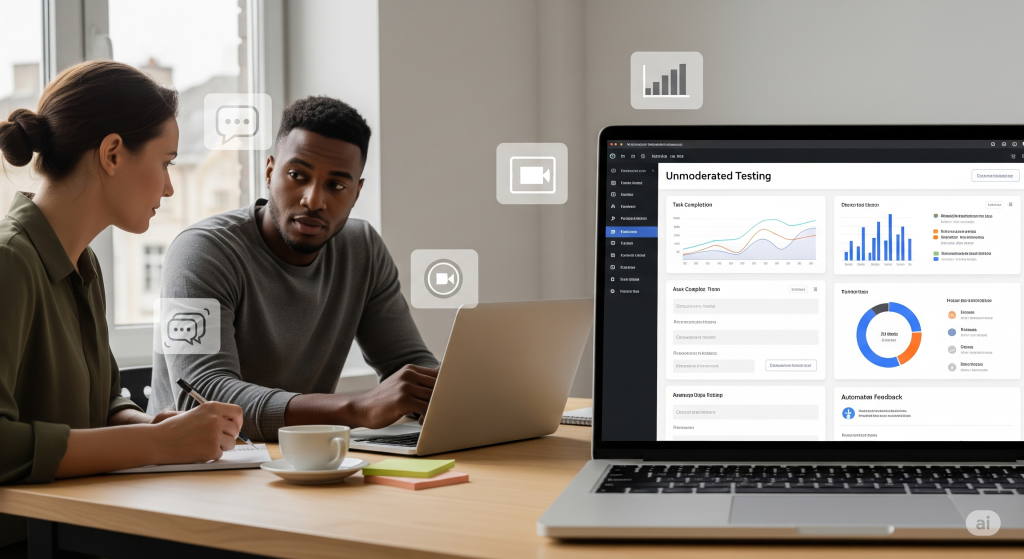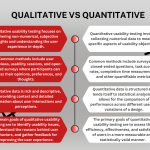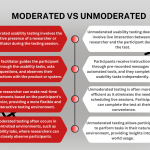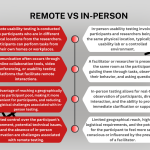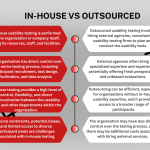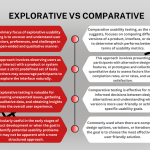In the fast-paced digital era, ensuring your company’s online presence is user-friendly is crucial for success. As a company owner, you want to make sure that your website or application not only attracts visitors but also keeps them engaged. This is where usability testing becomes your secret weapon. In this ultimate guide, we’ll delve into the world of usability testing, breaking down its importance, methods, and how it can significantly impact your business.
What is Usability Testing?
Usability testing stands out as a primary method for assessing the effectiveness of your app or website. This technique involves engaging users from your target audience in a structured evaluation, where they perform a series of tasks within a controlled environment, such as signing up or making a purchase. Observers keenly note instances of user success or challenges, providing valuable insights for subsequent design enhancements.
In essence, it is a systematic approach to gauge the functionality of a digital product, be it a website, application, or any other online platform. This evaluation entails the observation of authentic users by researchers affiliated with a business, conducted through either in-person sessions or, more commonly, remote usability testing sessions.
Why Usability Testing Matters?
Usability testing holds significant value as it involves real-life users who are adept at uncovering issues that individuals familiar with a website might overlook. In many cases, profound knowledge can blind designers, marketers, and product owners to the usability challenges a website might present.
Incorporating new users to assess your site or observing the interactions of existing users proves to be effective in determining whether your visitors:
Grasp how your site operates and avoid getting ‘lost’ or confused.
Complete essential actions.
Navigate without encountering usability issues or bugs.
Enjoy a functional and efficient overall experience.
Identify any other potential usability problems.
In essence, usability testing serves as a crucial tool for ensuring that your website is user-friendly and capable of delivering a seamless experience to a diverse audience.
Unveiling the User Experience (UX)
Consider usability testing as the exclusive backstage pass to your user’s experience. Picture hosting a spectacular event – the spotlight isn’t only on the main show but on the entire journey. Likewise, your website or app is a performance, and usability testing grants you access to comprehend what unfolds behind the curtains, offering valuable insights into the user’s journey.
Enhancing Customer Satisfaction
Satisfied users are your best brand ambassadors. Usability testing helps identify pain points and areas of improvement, leading to a seamless user experience. When your customers effortlessly navigate through your platform, satisfaction soars, and positive word-of-mouth spreads like wildfire.
Types of Usability Testing
Qualitative vs. Quantitative
Qualitative usability testing aims to explore and understand the user experience in a nuanced and subjective way, using methods that allow participants to express their thoughts and feelings. On the other hand, quantitative usability testing focuses on obtaining numerical measurements to assess specific aspects of usability in a more objective and standardized manner. Both approaches are valuable and are often used in combination to gain a comprehensive understanding of the usability of a product or system.
Moderated vs. Unmoderated
Moderated usability testing involves direct interaction between a researcher and a participant, providing the opportunity for in-depth exploration and adjustments based on real-time insights. Unmoderated usability testing, on the other hand, relies on automated tools and participants’ independent completion of tasks, offering efficiency and the ability to collect data from more participants. Both approaches have their advantages and are chosen based on the goals, resources, and constraints of a usability study.
Remote vs. In-Person Testing
Remote usability testing is conducted with participants in different locations, leveraging online communication tools, while in-person usability testing involves participants and researchers physically present in the same location. Each approach has its own set of advantages and challenges, and the choice between remote and in-person testing depends on factors such as the goals of the study, participant accessibility, logistical considerations, and the depth of interaction required with participants.
In-house vs. Outsourced
In-house usability testing is performed by the organization using its resources, providing control and direct communication. Outsourced usability testing involves hiring external experts or agencies to conduct usability testing, leveraging their specialized skills and potentially widening the participant pool. The choice between in-house and outsourced testing depends on factors such as the organization’s capabilities, expertise, resources, and the specific goals of the usability study.
Explorative and Comparative
Explorative usability testing is more qualitative and open-ended, aiming to uncover insights into user behavior and experiences without a predefined script. Comparative usability testing, on the other hand, involves a more structured and quantitative approach, focusing on comparing different designs or versions to make informed decisions about usability improvements. Both approaches have their place in usability testing, and the choice between them depends on the goals and stage of the product development process.
Usability Testing Components
The Facilitator/Moderator
In the realm of usability testing, the facilitator or moderator assumes a pivotal role in orchestrating, executing, and dissecting the usability test. Proficiency in observational and analytical skills is imperative for the facilitator, along with the ability to engage effectively with participants. Their role extends beyond mere coordination, encompassing a keen understanding of user behavior and an insightful analysis of the testing process.
Tasks for Participants
The tasks assigned to participants should mirror real-world scenarios, encapsulating a comprehensive spectrum of interactions users might have with the product. These tasks are meticulously designed to simulate authentic user experiences, allowing for a thorough examination of the product’s usability under diverse circumstances.
The Participants
The participants selected for usability testing serve as representatives of the product’s target audience. Their feedback, reactions, and interactions during the testing phase furnish invaluable insights into the usability of the product. By closely aligning with the characteristics of the target audience, the participants ensure that the testing process generates relevant and actionable feedback.
Environment and Tools
The environment in which usability testing unfolds, coupled with the tools employed, significantly influences the quality of the results. An environment that closely replicates the user’s natural setting enhances the authenticity of the testing process, while well-chosen tools facilitate the precise capture of user interactions. The synergy between a conducive environment and appropriate tools is key to extracting accurate and meaningful usability data.
Data Analysis and Interpretation
Post the execution of usability tests, the collected data undergoes rigorous analysis and interpretation by data experts. This analytical process centers on identifying patterns, decoding user behaviors, and drawing actionable conclusions to guide product enhancements. The culmination of this analysis is a comprehensive report that not only visualizes the interpreted data but is also crafted in a manner accessible to various stakeholders, ranging from product owners to company executives, facilitating a collective understanding of the usability insights.
Stages of Usability Testing
-
Strategic Planning and Objectives Definition
Embarking on effective usability testing starts with meticulous strategic planning and defining clear objectives. Product owners take the lead in this phase by articulating learning objectives, setting measurable goals, and selecting metrics to gauge success. This groundwork ensures a focused testing process, generating actionable insights for increased productivity.
-
Designing User Tasks for Realistic Interaction
A pivotal aspect of usability testing involves crafting tasks that authentically mirror user interactions. These tasks, covering various functionalities, aim to elicit meaningful responses. Balancing simplicity and specificity, the tasks reflect natural user behavior while providing accurate data on usage and behavior, capturing a comprehensive understanding of user engagement.
-
Diverse Tester Recruitment
Central to the usability testing process is recruiting a diverse group of testers representative of the target audience. The backgrounds, skills, and experiences of testers should align with those of typical product users. This alignment ensures that the feedback received is not only relevant but also applicable to the broader user base, enhancing the overall effectiveness of the testing process.
-
Effective Facilitation and Unbiased Moderation
The success of usability testing hinges on effective facilitation and unbiased moderation during testing sessions. Facilitators guide participants through tasks without leading, fostering an environment where users feel comfortable providing honest feedback. This approach ensures that the testing remains objective, and the insights garnered are reflective of genuine user experiences.
-
Analysis of User Behavior for Critical Insights
Critical insights emerge from the analysis of user behavior during testing sessions. Observing user interactions, identifying pain points, and understanding user needs and challenges are paramount to improving usability. Experienced moderators, with their knowledge of various behavioral patterns, play a crucial role in providing developers with essential information to enhance product design and functionality.
-
Compilation of a Comprehensive Test Report
The culmination of the usability testing process involves compiling a detailed report summarizing findings, observations, and actionable recommendations. This comprehensive report serves as a guide for designers and developers, facilitating informed decision-making and subsequent improvements to the product.
Key Benefits of Usability Testing
Usability testing isn’t just a formality; it’s a strategic investment that yields numerous benefits, significantly impacting the success of a digital product or service.
Higher Conversion Rates
One of the primary advantages of usability testing is its direct impact on conversion rates. By identifying and rectifying usability issues, the user journey becomes smoother, reducing friction and increasing the likelihood of users completing desired actions. This, in turn, translates to higher conversion rates, positively influencing the overall success of your digital venture.
Competitive Advantage
In a competitive market, standing out is crucial. Usability testing provides a distinct edge by ensuring that your product is not just functional but also user-friendly. A seamless user experience sets your offering apart, attracting and retaining customers who appreciate an intuitive and enjoyable interaction. This competitive advantage can be a game-changer in saturated markets.
Enhancing User Experience
User experience is at the core of usability testing. By uncovering and addressing pain points, the overall user experience is enhanced. Users are more likely to engage, explore, and return to a platform that understands and caters to their needs. Usability testing acts as a compass, guiding the development process towards creating products that users genuinely enjoy using.
Improve Customer Satisfaction
Satisfied customers are the lifeblood of any business. Usability testing identifies areas for improvement, ensuring that the final product aligns with user expectations. This alignment leads to heightened customer satisfaction, fostering loyalty, positive reviews, and, ultimately, a stronger brand-consumer relationship.
Improved Brand Reputation
A positive user experience through effective usability testing contributes to an enhanced brand reputation. Users appreciate products that work seamlessly and are easy to use. Word-of-mouth recommendations and positive online reviews can significantly boost your brand’s standing in the market, attracting a larger user base.
In conclusion, the benefits of usability testing extend far beyond the development phase, influencing the success and sustainability of a digital product in today’s competitive landscape.
Conclusion
In today’s ever-changing digital world, where delivering exceptional user experiences is crucial, companies rely on usability testing to steer them toward success. It’s not just a routine part of development; rather, it’s a strategic investment with significant implications.
Usability testing goes beyond identifying and fixing issues; it’s about creating a digital experience that truly connects with users, fosters loyal advocates, and ultimately determines a product’s triumph in a competitive market. For more information, please visit user.com.sg.


